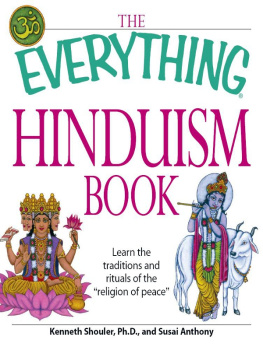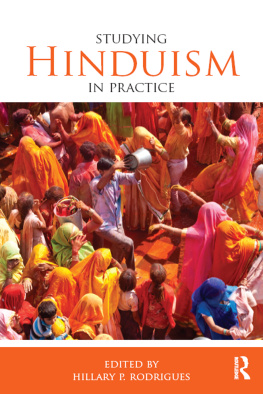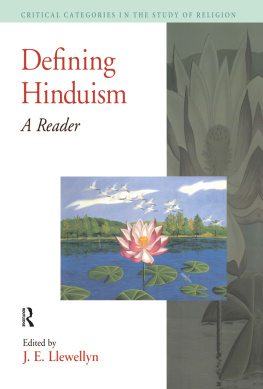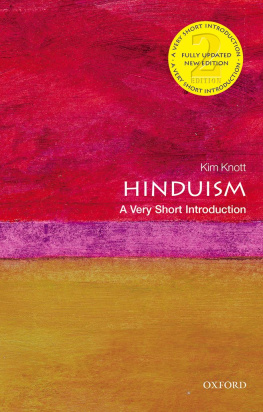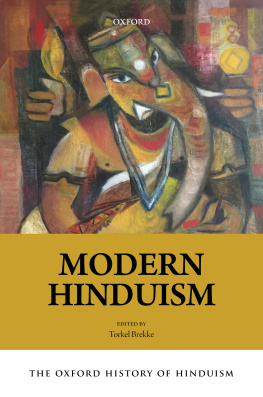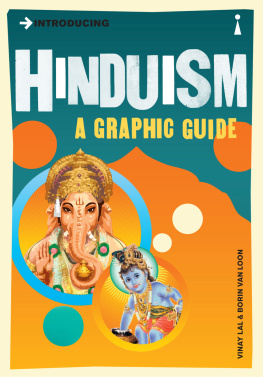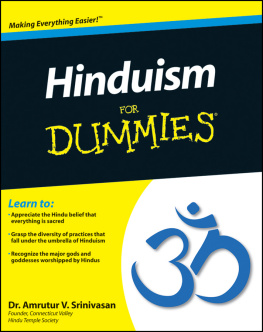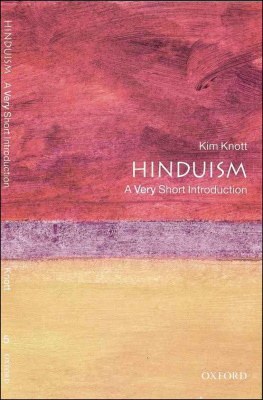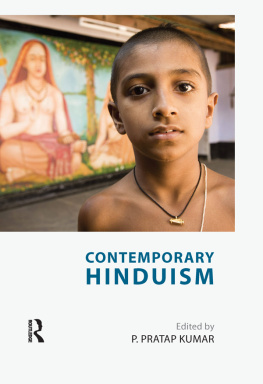Flueckiger - Everyday Hinduism
Here you can read online Flueckiger - Everyday Hinduism full text of the book (entire story) in english for free. Download pdf and epub, get meaning, cover and reviews about this ebook. City: Hoboken, year: 2015, publisher: Wiley-Blackwell, genre: Home and family. Description of the work, (preface) as well as reviews are available. Best literature library LitArk.com created for fans of good reading and offers a wide selection of genres:
Romance novel
Science fiction
Adventure
Detective
Science
History
Home and family
Prose
Art
Politics
Computer
Non-fiction
Religion
Business
Children
Humor
Choose a favorite category and find really read worthwhile books. Enjoy immersion in the world of imagination, feel the emotions of the characters or learn something new for yourself, make an fascinating discovery.

- Book:Everyday Hinduism
- Author:
- Publisher:Wiley-Blackwell
- Genre:
- Year:2015
- City:Hoboken
- Rating:4 / 5
- Favourites:Add to favourites
- Your mark:
- 80
- 1
- 2
- 3
- 4
- 5
Everyday Hinduism: summary, description and annotation
We offer to read an annotation, description, summary or preface (depends on what the author of the book "Everyday Hinduism" wrote himself). If you haven't found the necessary information about the book — write in the comments, we will try to find it.
Everyday Hinduism — read online for free the complete book (whole text) full work
Below is the text of the book, divided by pages. System saving the place of the last page read, allows you to conveniently read the book "Everyday Hinduism" online for free, without having to search again every time where you left off. Put a bookmark, and you can go to the page where you finished reading at any time.
Font size:
Interval:
Bookmark:

- Chapter 01
- Chapter 02
- Chapter 03
- Chapter 04
- Chapter 05
- Chapter 06
- Chapter 07
- Chapter 08
Joyce Burkhalter Flueckiger

This edition first published 2015
2015 Joyce Burkhalter Flueckiger
Registered Office
John Wiley & Sons, Ltd, The Atrium, Southern Gate, Chichester, West Sussex, PO19 8SQ, UK
Editorial Offices
350 Main Street, Malden, MA 02148-5020, USA
9600 Garsington Road, Oxford, OX4 2DQ, UK
The Atrium, Southern Gate, Chichester, West Sussex, PO19 8SQ, UK
For details of our global editorial offices, for customer services, and for information about how to apply for permission to reuse the copyright material in this book please see our website at www.wiley.com/wiley-blackwell.
The right of Joyce Burkhalter Flueckiger to be identified as the author of this work has been asserted in accordance with the UK Copyright, Designs and Patents Act 1988.
All rights reserved. No part of this publication may be reproduced, stored in a retrieval system, or transmitted, in any form or by any means, electronic, mechanical, photocopying, recording or otherwise, except as permitted by the UK Copyright, Designs and Patents Act 1988, without the prior permission of the publisher.
Wiley also publishes its books in a variety of electronic formats. Some content that appears in print may not be available in electronic books.
Designations used by companies to distinguish their products are often claimed as trademarks. All brand names and product names used in this book are trade names, service marks, trademarks or registered trademarks of their respective owners. The publisher is not associated with any product or vendor mentioned in this book.
Limit of Liability/Disclaimer of Warranty: While the publisher and author have used their best efforts in preparing this book, they make no representations or warranties with respect to the accuracy or completeness of the contents of this book and specifically disclaim any implied warranties of merchantability or fitness for a particular purpose. It is sold on the understanding that the publisher is not engaged in rendering professional services and neither the publisher nor the author shall be liable for damages arising herefrom. If professional advice or other expert assistance is required, the services of a competent professional should be sought.
Library of Congress Cataloging-in-Publication Data is available for this title
Hardback ISBN: 9781405160117
Paperback ISBN: 9781405160216
A catalogue record for this book is available from the British Library.
Cover image: Jamini Roy (18871972), Three Pujarins, tempera on board, 36.5 70.5cm. National Gallery of Modern Art, New Delhi
My first thanks go to the many families and individuals I have worked with and learned from over my many years of ethnographic research in Chhattisgarh, Hyderabad, Tirupati, and Atlanta many of whom have become close friends and family. This book would not have been possible without them.
The approach and topics of this book developed, in part, through teaching a course at Emory University titled Introduction to Religion: Hinduism and Judaism, which I have co-taught many times with Michael Berger. I have learned from Michael new perspectives on Jewish traditions, many creative teaching methods, and ways to engage in comparison. This class has been one motivator in writing this book, and Michaels encouragement and collegiality have been invaluable.
In the first iterations of the class, some Hindu students objected to inclusion of some topics (such as caste or possession) that they had not heard about growing up, about which they had been taught differently, or that their families did not practice. I learned from them clearer ways to frame these topics and, more specifically, to make a distinction between Hindu practices in India and those their families may practice in the United States. I have also learned about a wide range of Hindu practices in the diaspora from these students and their families.
I also thank the Emory University graduate students on whose dissertation committees I have served and from whom I continue to learn (and some of whose ethnographic observations have entered this book). My gratitude extends to my colleagues Amy Allocco, Jenn Ortegren, Harshita Mruthinti Kamath, Kate Zubko, Paul Courtright, and Tara Doyle, who all read select chapters of this book and gave invaluable feedback. V. Narayana Rao read the entire manuscript, and we spent many hours talking about both the topics and the examples that found their way into the book, and many that did not.
Finally, I thank the engaged editors with whom I have worked at Wiley Blackwell Rebecca Harkin and Georgina Coleby. Rebecca first approached me about writing this book for a Wiley series on Everyday Religion, and encouraged me to persevere in the project when other demands threatened to derail it. Georginas periodic encouraging emails also helped to keep the book on track, and she was diligent in following through with many publication details. Giles Flitney was a conscientious copy-editor. It was a joy to work with such enthusiastic and responsive editors.
To read roman transliterations of Indian-language words can be frustrating to those who dont know these languages, particularly given the varieties of transliteration systems that a reader may come across in different publications. I encourage readers to experience these variations as part of the polytheistic imagination of Indian traditions (see Introduction).
Many terms in this book are shared across Indian languages with slightly different pronunciations, and thus transliterations. For example, the name of the god Rama is pronounced with the final a in Sanskrit and Telugu, but in Hindi it is pronounced without the final a, thus Ram. Or the term for vow in Sanskrit is pronounced vrata, but in Hindi, vrat. Other terms have greater variations; for example, the festival of lights may be called Divali or Dipavali (lit., row of lights). I will use the Sanskrit transliteration for proper names (Rama, Ganesha) but will leave off the final a for other nouns (such as prasad instead of prasada, darshan instead of darshana, vrat instead of vrata), since these are the pronunciations closer to the regional spoken languages in which I have worked.
Standard academic transliteration of Indian-language terms often uses diacritics, which I have chosen not to do on the assumption that those who do not know Indian languages will not know the conventions of the diacritics and that those who do know Indian languages will not need diacritics to correctly pronounce the word. Rather, I render transliterations as close as possible to what will result in correct English pronunciation. Thus, I render both and s as sh; shakti (spiritual power) rather than akti. Further, I have indicated aspirated consonants with an h: chaturthi (the fourth day) such as Ganesha Chaturthi rather than rendering the word according to standard academic transliteration of caturthi.
In direct quotations from authors who have used diacritics, the diacritics will not be indicated; so in these cases the reader will notice, for example, spellings of Shiva as Siva, or Vishnu as Visnu. I have indicated Indian-language terms (except for proper nouns) with italics and, for clarity, have chosen to italicize the s that indicates plural in English, although this s is not the way in which Indian languages indicate plural.
Next pageFont size:
Interval:
Bookmark:
Similar books «Everyday Hinduism»
Look at similar books to Everyday Hinduism. We have selected literature similar in name and meaning in the hope of providing readers with more options to find new, interesting, not yet read works.
Discussion, reviews of the book Everyday Hinduism and just readers' own opinions. Leave your comments, write what you think about the work, its meaning or the main characters. Specify what exactly you liked and what you didn't like, and why you think so.

